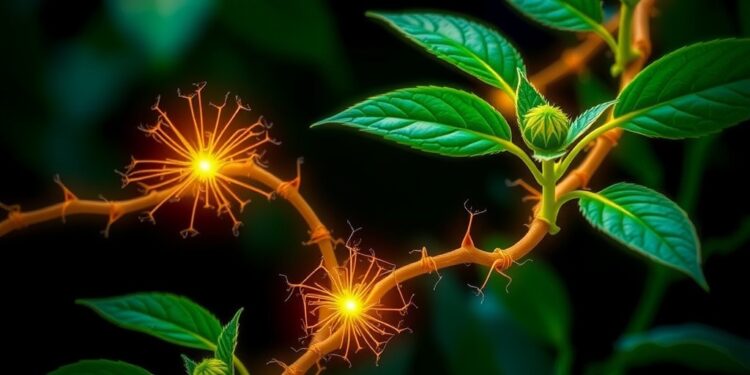
The dream of efficiently converting solar energy into storable chemical energy has tantalized engineers and scientists alike for decades. However, this seemingly futuristic aspiration is not just a product of human ingenuity; it has existed in nature for billions of years. Recent research now suggests that the principles of quantum mechanics, often reserved for the discussions of physicists, are central to biological processes. More specifically, these principles play a key role in how photosynthetic organisms, including green plants, convert sunlight into useful energy.
At the heart of this remarkable transformation is chlorophyll, the green pigment found in plants that enables them to capture sunlight. According to Professor Jürgen Hauer, a leading researcher in this field, when light is absorbed by chlorophyll molecules in a leaf, an extraordinary quantum mechanical phenomenon occurs. The energy generated by the absorbed light exists in a state of superposition, wherein it is distributed across various excited states of the chlorophyll molecules involved. This pivotal first step fosters a near-loss-less energy transfer within and between the molecules that facilitates the efficient subsequent transport of solar energy throughout the organism.
This energy transfer is not just an abstract concept; it is a constant occurrence that happens unobtrusively in green plants and other photosynthetic entities, including certain bacteria. Despite its prevalence in nature, a thorough understanding of the intricate mechanisms at play has remained elusive until now. Through their pioneering study, Hauer and lead author Erika Keil aim to establish a new foundation for decoding the complexities surrounding chlorophyll’s functionality, which could have far-reaching implications for developing artificial photosynthesis systems capable of harnessing solar energy with astounding efficiency.
In their exploration, the researchers focused on two specific regions of the light spectrum where chlorophyll optimally absorbs sunlight: the low-energy Q region, spanning the yellow to red spectrum, and the high-energy B region, which includes blue and green wavelengths. Notably, the Q region consists of two distinct electronic states that exhibit quantum mechanical coupling. This coupling is critical as it results in the lossless transport of energy within chlorophyll molecules. Following this energy transfer, the system undergoes a natural relaxation process known as “cooling,” during which it dissipates energy in the form of heat. This study illustrates the profound impact that quantum mechanical effects exert on biologically significant processes.
Analyzing energy transfer dynamics at this quantum level unravels a deeper understanding of efficiency in nature. Traditional thermodynamic models fail to capture the intricacies of how energy can be channeled with minimal losses, making this research pivotal not just for theoretical science but also for practical applications. By bridging biology and quantum mechanics, the scientists behind this study contribute to a clearer vision of how harnessing solar energy could potentially become as efficient as the natural systems already in play.
Moreover, understanding the mechanisms behind such efficiency may provide scientists with insights into creating artificial systems that mimic these natural processes. Such innovations could revolutionize energy generation and storage, paving the way for advancements that utilize solar energy in ways previously deemed unattainable. The culmination of this research signifies a critical step towards systems that could lead to cleaner energy generation and an increased reliance on renewable resources.
As we delve deeper into the realm of quantum biology—where classical physics meets the subtle intricacies of quantum mechanics—we can better appreciate the amazing efficiencies achieved by nature. The implications stretch beyond energy capture and storage; they invite innovative thinking across disciplines that could alter our relationship with energy. The potential for developing technologies that imitate nature’s brilliance in harnessing solar energy is thrilling; every step taken forward in this field opens doors to new scientific inquiries and industrial opportunities.
In summary, the work of Hauer, Keil, and their colleagues expands our knowledge of chlorophyll and its role in photosynthesis beyond what was previously understood. Challenging accepted paradigms and providing empirical evidence of quantum effects at play, this research encourages further investigation into nature’s mechanisms. Importantly, as engineers and scientists push the boundaries of what is possible in artificial energy harnessing, the balanced interplay between biology and quantum mechanics will invariably capture the interest of a broader audience, igniting fervor for future advancements.
Looking ahead, we stand at an exciting intersection of technology and nature. The findings from this research not only enhance our understanding of biological processes but also symbolize an important milestone in the pursuit of sustainable energy solutions. By harnessing the scientific legacy of natural processes refined over millennia, we may one day create efficient systems that generate and store clean energy on a global scale. As our understanding of quantum biology advances, the dream of achieving a solar-powered future may become significantly more tangible.
Subject of Research:
Article Title: Reassessing the role and lifetime of Qx in the energy transfer dynamics of chlorophyll a
News Publication Date: 27-Nov-2024
Web References: 10.1039/D4SC06441K
References:
Image Credits:
Keywords
Quantum mechanics, Photosynthesis, Chlorophyll, Energy transfer, Solar energy, Renewable resources, Quantum biology, Artificial photosynthesis, Energy storage, Sustainability, Chemical energy, Efficiency.
Tags: biological processes using quantum principleschlorophyll’s role in energy transportefficient solar energy conversion in plantsenergy transfer mechanisms in plantsgreen plants and solar energynature’s energy transport systemsphotosynthetic organisms and energyProfessor Jürgen Hauer’s research on photosynthesisquantum mechanics in photosynthesisresearch on plant energy efficiencystorable chemical energy from sunlightsuperposition in chlorophyll molecules






